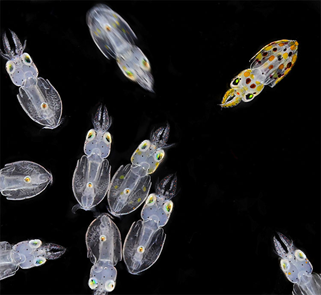The Albrecht Group in the Department of Biology at the University of Fribourg, investigates circadian rhythms in biological systems. Recently Urs Albrecht submitted a photo of baby squid for the Swiss Art + Science Competition sponsored by Promega AG. We have covered squid communication in a separate blog. Here we talk to him about the photo and the inspiration behind it.
How did you become interested in squids as an experimental model?

My lab works mainly with mice. Other professors work with different organisms such as Drosophila, C. elegans, plants, and yeast at our university. One of them, Simon Sprecher, became interested in marine biology and started a course for students. I immediately thought that’s a great idea because it is something different, and few actually look deeply into the biology of marine organisms. The literature on squids is scarce and old, and they are challenging to keep in lab conditions. Yet, my colleague ordered Loligo vulgaris eggs from Villefranche Sur Mer in France and started establishing them to hatch and grow in Fribourg. He was successful. The next step was setting up experimentation. However, squids have brains, and to carry out experiments with them, we needed to apply for authorization from the Swiss Government. I helped out, but it was challenging because there were no standards and regulations, as nobody works on these animals in Switzerland. Now we are interested in studying the communication between squids. It is easy to observe how they change color, because they are transparent. The change in color is related to their stress level and mood.
What went into taking the image “One Out”?
I’ve been a hobby photographer since I am ten years old. So when I went to my colleague’s lab and looked at the baby squids, I said, “Ohh, they are beautiful.” They looked really stunning, and some of them started changing colors in front of me. I thought that was a fascinating behavior, and I wanted to capture that.

Baby squids are transparent and colorful. I had to think about how I could best picture them. I decided to have them in a Petri dish and put them on a stand with lighting coming from below on a black background. I made several images. On one of them, there was this situation where one of the squids was changing color. It was very different from all the others. It immediately came to my mind that something was happening. They were communicating.
What prompted you to participate in the Science + Art competition?
I think that it is a general human urge to share how you see the world. And because you’re interacting with others, you can get a measure of whether they see it the same way or not. It’s always risky because people can love it or hate it. It is then your choice to rationally analyze why somebody likes something or not and gain experience from it.
To you, how are art and science different?
Science is rational. It is based on investigations to link information together. Art is the exact opposite. It’s irrational as it is about feelings and emotions aroused by what you sense. Yet, both science and art are driven by interpretation. In science, you obtain analytical results and interpret them using your imagination as well. Whereas in art, it is the other way around. You first make an interpretation, and then you start capturing it with a rational machine (e.g., a camera or a pen). Art and science are the two poles of a similar creative process.
Art and science are the two poles of a similar creative process.
Urs Albrecht
What do you want people to think when looking at “One Out”?
“One Out” shows two different groups, with one individual being in the minority, maybe scared or angry for some unknown reason. I took the picture because I thought this happens in our societies as well. Fate had it that some weeks later, war broke out in Ukraine. The important message to me is that we humans behave similarly to “simpler” animals – they are really not that simple. So, humans must be humbler towards nature when looking at it because although we always say we are better, we are not. We are very similar and not much different.
There is this push to reduce animal experimentation and use more cell-based systems. What do you think of this development, and do you believe that we will be able to do only animal-free experiments one day?
Doing exclusively animal-free experimentation would mean ignoring certain aspects such as communication within the system one is studying. This is not desirable in science and research. Studying cells doesn’t allow you to draw conclusions about an entire organism’s functioning. Let’s take the example of depression, which manifests the communication between brain cells. If you study neurons or only the brain, you cannot understand depression entirely because cells don’t show behavior. Of course, there is a need to control how people experiment with animals to avoid abuse. Whenever conducting experiments on animals, we must be responsible, avoid unnecessary suffering and behave ethically. Unfortunately, regardless of all the rules we set, there will always be a minority that will break them.
